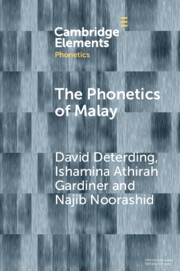Element contents
The Phonetics of Malay
Published online by Cambridge University Press: 03 February 2022
Summary
Information
- Type
- Element
- Information
- Series: Elements in PhoneticsOnline ISBN: 9781108942836Publisher: Cambridge University PressPrint publication: 19 May 2022
